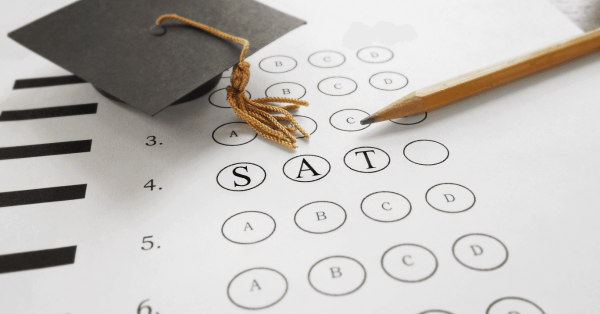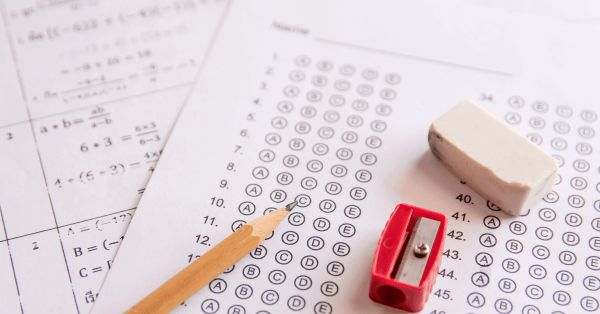Published March 5, 2021 | Last Updated March 5th, 2024 at 11:12 am

Editor’s Note: The SAT has gone digital as of March 2024.
As the parent or guardian of a college-bound student, you have probably done at least a little worrying about the SAT. While this is entirely understandable, the standardized test need not be a source of fear. The simple antidote is to go in with, and stick to, a plan.
Technically speaking, students can schedule an SAT at any point in their high school career, even freshman year, but most wait until later to take this major step.
The College Board, which creates and administers the test, recommends that college-bound students take an SAT in the spring of their junior year, and a second in the fall of their senior year.
Bobby Hood, test preparation expert, and tutor at Noodle Pros, however, recommends that students wrap up their SAT journey in junior year to avoid overburdening themselves later on. This would entail landing a satisfactory score by June of 11th grade, bearing in mind that the definition of satisfactory will vary from student to student.
Hood also recommends that your student begin preparing for the SAT between six weeks and two months in advance of their first test date.
His strategy involves scheduling two official SATs (not practice versions), one following an initial study period and a second at some later date; this second date may be canceled if your student achieves a score you both are satisfied with their first attempt.
This schedule can and should be adjusted to the test-taker’s level of proficiency, but studying for longer than three months is not advised.
A year-long SAT bootcamp might soothe your nerves, but it is far more likely to frustrate and exhaust your student than improve their scores.
While it’s possible to study for the SAT alone—say, with one of the many books published on the subject (Hood recommends the Princeton Review series)—there are many reasons to consider more social options.
SAT tutoring, especially one-on-one, can offer your student a learning environment that is both challenging and tailored to their needs.
An SAT prep course, many of which are available online, is another great strategy; in addition to providing college-bound students with diverse study tools, these courses can offer structure and direction that might be lacking in their self-directed efforts.
Some courses may even include in-person SAT prep classes when these become safe to administer in light of COVID-19.
Your student might also benefit from launching or joining an SAT study group to complement SAT prep classes.
These arrangements can easily go off-track, but so long as members remain committed, they can be a great way to fend off test jitters and develop valuable communication and leadership skills.
College Board claims that students who study in groups learn over twice as much as those who go it alone.
There is no one-size-fits-all formula for acing the SAT, so your student should start with an awareness of their own strengths and weaknesses.
Which topics and question formats can they breeze through by instinct, and which ones are liable to stop them in their tracks and eat up time?
The best way to answer these questions—and to establish priorities for an SAT study guide—is to begin with a practice test; this will give you and your student a base score to work from and a good idea of what topics and skills need the most attention.
The Preliminary SAT/National Merit Scholarship Qualifying Test (PSAT/NMSQT), also administered by the College Board, is a great option if your student is willing to begin their prep in a more formal testing environment.
Khan Academy, a non-profit which provides free SAT study resources (as well as sample study schedules), recommends that your student self-administer two full-length, timed practice tests: one at the beginning of their study regiment, and one near its end.
It also recommends administering at least one of these practice tests on paper.
Mimicking the conditions of a real-life SAT will better prepare your student for the qualities of a test that are not reducible to content: wrist pains, eraser marks, and the stress of a ticking clock. For the same reason, your student should probably familiarize themselves with test-day formalities and procedures.
The College Board’s web page on this subject is a good place to start.
The structure of the SAT is another important factor to keep in mind. The test begins with a 65-minute Reading Comprehension section.
If your student struggles with maintaining focus, or with the academic and unfamiliar language found in the reading samples, this could make for a challenge.
The 25-minute Math No-Calculator section might present a different kind of trouble by combining a short time limit with the unfamiliarity of working entirely by hand.
In short, your student should consider where the sections they find most difficult fall in the testing period and how to accommodate for them.
Ultimately, the most crucial step in preparing for the SAT is encouraging your student to set achievable goals and work towards them.
An overall score improvement of more than 100 to 200 points is very unlikely and a grueling study regiment is unlikely to have positive results.
It is far better to sit down with your child, discuss their college plans, and come up with an SAT study schedule that is good for both their academic aspirations and their health.
CONNECT WITH OTHER PARENTS TRYING TO FIGURE OUT
HOW TO PAY FOR COLLEGE
JOIN ONE OF OUR FACEBOOK GROUPS:

The SAT, or Scholastic Aptitude Test, is a standardized test administered by the College Board. U.S. colleges widely use it...

Table of Contents More than 1.5 million high school students take the Preliminary SAT (PSAT) each year. This guide explains...

One of the questions parents frequently ask is whether students should take the SAT or ACT. I always respond that...
At Road2College you’ll find everything you need to make the admissions and paying for college process less stressful and more transparent.
Explore R2C Insights™ — your source for finding affordable colleges and merit scholarships.
Get coaching on admissions and college financing.
Join Road2College where parents and experts work together to inform and inspire college-bound families.
By Grade:
By Stage in the Process:
Ad Policy Disclaimer: Product name, logo, brands, and other trademarks featured or referred to within Road2College are the property of their respective trademark holders. Information obtained via Road2College™ is for educational purposes only. Please consult a licensed financial professional before making any financial decisions. This site may be compensated through third party advertisers. This site is not endorsed or affiliated with the U.S. Department of Education. By visiting Road2College’s site, you accept and agree to be bound by Road2College’s Terms of Use.